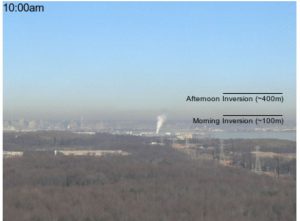Air quality is a measure of pollution in the surrounding air over a period of time. There are many different sources of air pollutants, and various weather factors, that can affect air quality on a daily basis. Some examples of pollution sources include emissions from energy production, vehicle exhaust, solvent fumes, methane from waste, smoke, and organic matter (e.g. pollen). The quality of the air, both indoors and out, can have a significant impact on the health of the UMBC community and that of the surrounding natural environment.
Air pollution hangs over downtown Baltimore in this photo from MDE in early January 2016. A winter weather condition, known as an inversion, can trap pollution from cars, industrial activity, and other combustion sources close to the ground. The markings on the image show how the pollution lifted during the day as the air warmed up.
Air Quality Index
Think of the Air Quality Index (AQI) as a yardstick that runs from 0 to 500. The higher the AQI value, the greater the level of air pollution and the greater the health concern. For example, an AQI value of 50 or below represents good air quality, while an AQI value over 300 represents hazardous air quality.
For each pollutant, an AQI value of 100 generally corresponds to an ambient air concentration that equals the level of the short-term national ambient air quality standard for the protection of public health. AQI values at or below 100 are generally thought of as satisfactory. When AQI values are above 100, air quality is unhealthy: at first for certain sensitive groups of people, then for everyone as AQI values get higher.
The AQI is divided into six categories. Each category corresponds to a different level of health concern. Each category also has a specific color. The color makes it easy for people to quickly determine whether air quality is reaching unhealthy levels in their communities.
